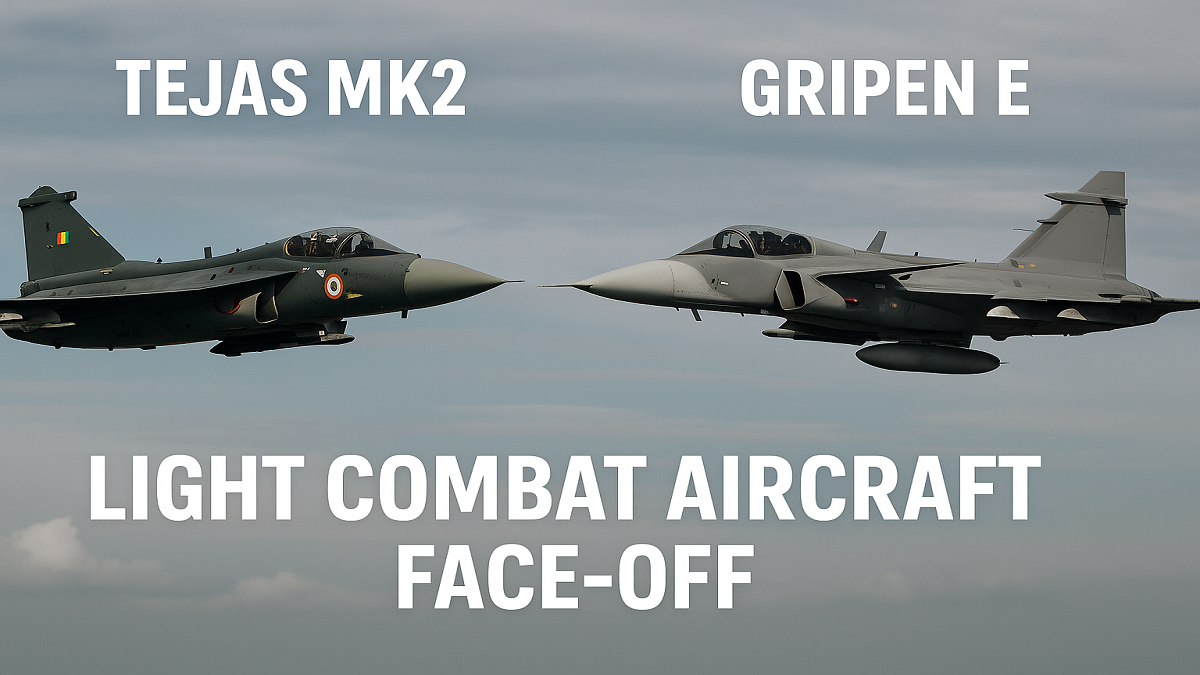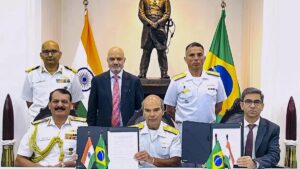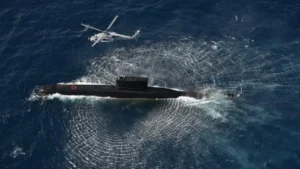As global air forces modernize their fleets, light combat aircraft (LCA) are gaining renewed attention for their affordability, agility, and versatility. Two contenders standing out in this domain are India’s Tejas Mk2 and Sweden’s Saab Gripen E. While both fighters are designed for multi-role operations and strike a balance between cost and performance, they are products of different defense philosophies and strategic requirements.
This article offers an in-depth comparison of the Tejas Mk2 and Gripen E across various parameters including design, avionics, engine performance, weapon systems, operational costs, and export potential.
1. Development Background
Tejas Mk2: India’s Indigenous Evolution
The Tejas Mk2 is an advanced development of the HAL Tejas Mk1, under the Medium Weight Fighter (MWF) category. Designed by the Aeronautical Development Agency (ADA) and manufactured by Hindustan Aeronautics Limited (HAL), the Mk2 is intended to fill the capability gap left by India’s aging MiG-29 and Mirage 2000 fleets. It represents India’s commitment to self-reliance under the ‘Atmanirbhar Bharat’ initiative.
- Maiden flight: Expected around 2025
- Full-rate production: Targeted by 2030
Gripen E: Sweden’s 21st-Century Answer
The Gripen E, also known as JAS 39E, is the latest variant of Saab’s Gripen family. Built for next-generation warfare, it is a product of Sweden’s defense needs with a focus on network-centric capabilities, cost-efficiency, and advanced interoperability with NATO forces. Developed with partial collaboration with Brazil (Gripen E/F variant), it reflects Saab’s modular and export-oriented design strategy.
- First flight: 2017
- Service entry: In progress with Swedish and Brazilian Air Forces
2. Airframe and Design Philosophy
Tejas Mk2
The Tejas Mk2 adopts a canard-delta configuration, enhancing its agility and maneuverability. It has a larger airframe than the Mk1, extended fuselage for more internal fuel, and a redesigned cockpit and undercarriage. Emphasis is placed on reduced radar cross-section (RCS) through structural shaping and composites.
- Length: ~14.6 m
- Max Takeoff Weight (MTOW): ~17.5 tons
- Internal fuel: ~3,400 kg
- Wing design: Cropped delta with close-coupled canards
Gripen E
Gripen E also features a delta wing with canards, allowing excellent short take-off and landing (STOL) capability. It integrates a modular architecture, making future upgrades easier. The use of advanced composites and internal sensors helps maintain a low RCS.
- Length: ~15.2 m
- MTOW: ~16.5 tons
- Internal fuel: ~3,400 kg
- Notable feature: Smart Maintenance System to reduce downtime
3. Avionics and Cockpit
Tejas Mk2
The Tejas Mk2 is expected to feature a multi-functional, glass cockpit, with Wide Area Display (WAD), a Digital Fly-by-Wire (FBW) system, and enhanced Electronic Warfare (EW) suite. It will also incorporate Artificial Intelligence (AI)-based systems, and will be equipped with an Active Electronically Scanned Array (AESA) radar (Uttam or Israeli EL/M-2052 as interim).
- Integrated sensors: Infrared Search and Track (IRST), Radar Warning Receivers (RWR)
- Data fusion: Multi-sensor for enhanced situational awareness
Gripen E
The Gripen E offers cutting-edge avionics, including WAD, Head-Up Display (HUD), and a Hands-On Throttle-And-Stick (HOTAS) system. It features the Raven ES-05 AESA radar, Skyward-G IRST, and advanced self-protection EW suite.
- Sensor fusion: Real-time integration of radar, IRST, EW, and tactical data link
- Tactical data sharing: Link 16 and Swedish TIDLS
4. Propulsion and Performance
Tejas Mk2
The Mk2 is powered by the General Electric F414-GE-INS6 engine, offering 98 kN of thrust, an upgrade from the F404 on the Mk1. This provides it with superior thrust-to-weight ratio, enabling better payload and range.
- Speed: Mach 1.8
- Combat range: ~1,500 km
- Service ceiling: 50,000 ft
Gripen E
The Gripen E also uses the F414-GE-39E engine, but integrates it with a more efficient airframe and advanced fuel systems. With similar thrust, it boasts impressive combat endurance and acceleration.
- Speed: Mach 2.0
- Combat range: ~1,500–1,800 km
- Service ceiling: 52,000 ft
5. Weapons and Combat Capabilities
Tejas Mk2
The Tejas Mk2 will be capable of carrying a wide array of air-to-air, air-to-ground, and anti-ship missiles, including:
- Astra Mk1/2, Derby, R-73, Python-5
- BrahMos-NG (future)
- Precision-guided bombs, laser-guided munitions
- 13 hardpoints for up to 6.5 tons of payload
Gripen E
Gripen E is designed for multi-role dominance with access to NATO-standard and Swedish weaponry:
- Meteor BVRAAM (beyond visual range air-to-air missile)
- IRIS-T, AMRAAM, RBS-15, Taurus KEPD 350
- 10 hardpoints with ~6 tons of payload
- Advanced target designation pods and recon systems
6. Cost, Maintenance, and Operational Readiness
Tejas Mk2
While cost estimates are evolving, the Tejas Mk2 is expected to remain significantly cheaper than Western fighters. Emphasis is on low life-cycle cost, ease of maintenance, and domestic supply chain development.
- Estimated cost per unit: ~$50–60 million
- Designed for Indian Air Force’s logistics infrastructure
Gripen E
The Gripen E has one of the lowest operational costs per flight hour among modern fighters (estimated at ~$4,700/hour). Saab promotes it as a “smart fighter” optimized for ease of upgrades and low logistical footprint.
- Estimated cost per unit: ~$80–85 million
- Quick turnaround time: 10 minutes for rearming and refueling
7. Export Potential and Strategic Partnerships
Tejas Mk2
While still under development, the Mk2 has generated interest from countries like Malaysia, Argentina, and Egypt. India is positioning it as a cost-effective alternative to pricier Western platforms with the added benefit of technology transfer and customization.
Gripen E
Gripen E has been offered to various countries including Finland, Canada, and Colombia, with Brazil being its most prominent export customer (Gripen E/F). Saab emphasizes its partnership model, including local assembly and technology sharing.



 Army Achieves Major Logistics Milestone ...
Army Achieves Major Logistics Milestone ...
 India and Brazil Sign Tripartite MoU on ...
India and Brazil Sign Tripartite MoU on ...
 Indian Navy to Commission INAS 335 (Ospr...
Indian Navy to Commission INAS 335 (Ospr...







